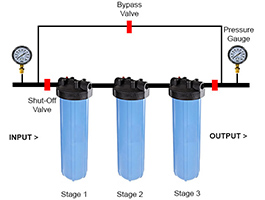Arsenic (As) is a semi-metal element of periodic table that can be found in drinking water. Arsenic is not easily dissolved in water, therefore, if it is found in a water supply.
If in an inorganic form, arsenic can be removed or reduced by conventional water treatment processes. There are five ways to remove inorganic contaminants; reverse osmosis, activated alumina, ion exchange, activated carbon, and distillation. Filtration through activated carbon will reduce the amount of arsenic in drinking water from 40 - 70%. Anion exchange can reduce it by 90 - 100%. Reverse Osmosis has a 90% removal rate, and Distillation will remove 98%. If the arsenic is present in organic form, it can be removed by oxidation of the organic material and subsequent coagulation.


Sand filtration is used for the removal of suspended matter, as well as floating and sinkable particles. The wastewater flows vertically through a fine bed of sand and/or gravel. Particles are removed by way of absorption or physical encapsulation. If there is excessive pressure loss on the filter, it must be rinsed.
The yield of a sand filter is determined by two sand filter functions, namely surface filtration and depth filtration. Surface filtration involves collecting the particles above the filter bed. These particles jointly form a macro-porous lump, which is able to collect new particles in a very effective manner. Depth filtration generally involves smaller particles that are more difficult to collect, and which are bound to the sand particles by adsorption. Dirt from surface filtration is easier to remove during reverse rinsing compared to dirt from depth filtration.
Activated carbon filtration (AC) is effective in reducing certain organic chemicals and chlorine in water. It can also reduce the quantity of lead in water although most lead-reducing systems use another filter medium in addition to carbon. Water is passed through granular or block carbon material to reduce toxic compounds as well as harmless taste- and odor-producing chemicals.
The principles of activated carbon filtration are the same as those of any other adsorption material. The contaminant is attracted to and held (adsorbed) on the surface of the carbon particles. The characteristics of the carbon material (particle and pore size, surface area, surface chemistry, density, and hardness) influence the efficiency of adsorption.
